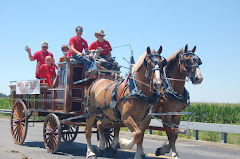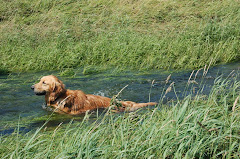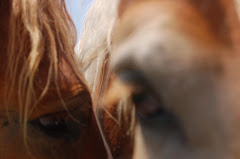 Reminder: Our 20th Anniversary Open House is next Saturday May 2, 2009 from 10:00am to 4:00pm . We are sprucing up the clinic, stocking up on refreshments and organizing demonstrations.
Reminder: Our 20th Anniversary Open House is next Saturday May 2, 2009 from 10:00am to 4:00pm . We are sprucing up the clinic, stocking up on refreshments and organizing demonstrations. 

Welcome to the Arthur Veterinary Clinic! The AVC is a veterinary clinic located in Arthur, Illinois. What makes the AVC unique is we are a mixed animal veterinary clinic, meaning we treat both companion animals and horses! Join us for interesting stories, pictures and information on dogs, cats & and horses. For more information, visit our website at www.arthurvetclinic.com
 Reminder: Our 20th Anniversary Open House is next Saturday May 2, 2009 from 10:00am to 4:00pm . We are sprucing up the clinic, stocking up on refreshments and organizing demonstrations.
Reminder: Our 20th Anniversary Open House is next Saturday May 2, 2009 from 10:00am to 4:00pm . We are sprucing up the clinic, stocking up on refreshments and organizing demonstrations. 

 Every year in the spring and fall, we see cases at the Arthur Veterinary Clinic where pets have ingested rat poison. Rat poison can be deadly to pets! While there are several types of rat poison or rodenticides available, the most common type used are anticoagulant rodenticides. I will discuss this type.
Every year in the spring and fall, we see cases at the Arthur Veterinary Clinic where pets have ingested rat poison. Rat poison can be deadly to pets! While there are several types of rat poison or rodenticides available, the most common type used are anticoagulant rodenticides. I will discuss this type.
 So....if you must use rat poison, you must keep your pets far, far away from the poison. Dogs and cats can be very clever and very sneaky. To be on the safe side, no poison should be on the premise where the pet lives.
So....if you must use rat poison, you must keep your pets far, far away from the poison. Dogs and cats can be very clever and very sneaky. To be on the safe side, no poison should be on the premise where the pet lives.
 This is used to perform a culture on a sample taken from an animal. The purpose of a culture is to identify the actual organism causing an infection. For the most part, a culture is taken with a sterile swab....for instance, a swab is taken of an infected ear. The swab is then plated or rubbed on the special plates which contain media to "grow" the organism causing the infection. The plates are placed in the incubator which is kept at 98 degrees. Usually, the infection is bacterial in origin but we can also identify yeast or fungal infections. The plates are then viewed at 24 and 48 hours. This photo shows a positive culture. Small white colonies of bacteria are seen growing on the blood agar (red) side and small bluish colonies are seen on the MacConkey agar (clear) side.
This is used to perform a culture on a sample taken from an animal. The purpose of a culture is to identify the actual organism causing an infection. For the most part, a culture is taken with a sterile swab....for instance, a swab is taken of an infected ear. The swab is then plated or rubbed on the special plates which contain media to "grow" the organism causing the infection. The plates are placed in the incubator which is kept at 98 degrees. Usually, the infection is bacterial in origin but we can also identify yeast or fungal infections. The plates are then viewed at 24 and 48 hours. This photo shows a positive culture. Small white colonies of bacteria are seen growing on the blood agar (red) side and small bluish colonies are seen on the MacConkey agar (clear) side.  These clusters of bacteria or fungus are then transferred to a sensitivity plate. Small discs impregnated with different antibiotics are added to the plate. This photo show the sensitivity plate with antibiotic impregnated discs.
These clusters of bacteria or fungus are then transferred to a sensitivity plate. Small discs impregnated with different antibiotics are added to the plate. This photo show the sensitivity plate with antibiotic impregnated discs.  If the infection or growth fails to grow around a certain antibiotic disc, a clear halo is seen surrounding the disc and the infection is said to be "sensitive" to that particular antibiotic......meaning that antibiotic can be used to treat the infection. If the infection continues to grow despite the antibiotic disc, the infection is said to be "resistant" to that antibiotic.....meaning that antibiotic should not be used to treat the infection. Areas that we typically culture are ears, skin, urine, abscesses and mare's uteri.
If the infection or growth fails to grow around a certain antibiotic disc, a clear halo is seen surrounding the disc and the infection is said to be "sensitive" to that particular antibiotic......meaning that antibiotic can be used to treat the infection. If the infection continues to grow despite the antibiotic disc, the infection is said to be "resistant" to that antibiotic.....meaning that antibiotic should not be used to treat the infection. Areas that we typically culture are ears, skin, urine, abscesses and mare's uteri.
 These diagnostic tests I have described are used almost daily at the Arthur Veterinary Clinic. We perform many other diagnostic tests and procedures both for preventative veterinary medicine and for diagnosis of disease, illness and injury. And what we do not perform in house, we send to different outside laboratories across the US. Hopefully, I have educated you about diagnostic tests. Also, I hope you are beginning to realize that veterinary medicine uses highly advanced and sophisticated supplies and equipment to diagnose, treat and prevent disease and illness in animals. And we, as veterinarians, do this for the health and well-being of the animals we see and love.
These diagnostic tests I have described are used almost daily at the Arthur Veterinary Clinic. We perform many other diagnostic tests and procedures both for preventative veterinary medicine and for diagnosis of disease, illness and injury. And what we do not perform in house, we send to different outside laboratories across the US. Hopefully, I have educated you about diagnostic tests. Also, I hope you are beginning to realize that veterinary medicine uses highly advanced and sophisticated supplies and equipment to diagnose, treat and prevent disease and illness in animals. And we, as veterinarians, do this for the health and well-being of the animals we see and love.  The other Snap test shown is the Foal CITE test. This test tests the IgG or antibody level in newborn foals. Foals obtain IgG in the first 12-18 hours from their mother's colostrum. This level should be over 800 mg/dl to provide passive immunity against infection in the newborn foal. We recommend this test on all newborn foals and we perform this test on all foals that are born at the clinic. With this test, the control dots are the two blue dots above the single test sample dot. As you can tell, the control dot on the left is a lighter shade of blue than the control dot on the right. The control dot on the left is the 400 mg/dl level and the control dot on the left is the 800 mg/dl level. The test sample dot should be as dark blue or darker than the right hand control dot for the sample to be over 800 mg/dl. Basically, the darker the better. Pale blue or white means the foal's IgG or antibody is low.
The other Snap test shown is the Foal CITE test. This test tests the IgG or antibody level in newborn foals. Foals obtain IgG in the first 12-18 hours from their mother's colostrum. This level should be over 800 mg/dl to provide passive immunity against infection in the newborn foal. We recommend this test on all newborn foals and we perform this test on all foals that are born at the clinic. With this test, the control dots are the two blue dots above the single test sample dot. As you can tell, the control dot on the left is a lighter shade of blue than the control dot on the right. The control dot on the left is the 400 mg/dl level and the control dot on the left is the 800 mg/dl level. The test sample dot should be as dark blue or darker than the right hand control dot for the sample to be over 800 mg/dl. Basically, the darker the better. Pale blue or white means the foal's IgG or antibody is low. Another common Snap test used tests for Feline Leukemia Virus and Feline Immunodeficiency Virus in cats.
Another common Snap test used tests for Feline Leukemia Virus and Feline Immunodeficiency Virus in cats. 


Urinalysis
Another common lab test performed is the urinalysis. Much information can be obtained from a urine sample. A urine sample can be collected from a pet in three ways. A "free catch" sample can be obtained while the pet is actually urinating.....which can be challenging! The drawback to analyzing a voided sample is the urine can be contaminated with bacteria, cells or blood from the reproductive tract which can make analyzing the results difficult. A urine sample can be obtained by catheterizing a pet. However, this can also result in blood and bacteria from the procedure.....plus it is uncomfortable for the pet. The third and preferred method of obtaining a urine sample is by cystocentesis. Cystocentesis involves introducing a small needle, preferably ultrasound guided, into the bladder and removing a urine sample with a syringe. This method is actually tolerated very well by the pet and provides the most accurate sample for analysis. A urinalysis consists of three parts. The first part involves dipping a reagent stick in the urine to test for blood, protein, glucose, bilirubin, pH and ketones. The second part involves testing the specific gravity or concentration of urine using a handheld refractometer. The last part involves looking at a centrifuged portion of the urine sample under the microscope. By doing so, we can look for bacteria, red blood cells, white blood cells, abnormal cells and crystals. This picture shows the reagent strip and the handheld refractometer. 
 I'd like to tell the story behind this picture. This is "Serena", a golden retriever mix who was rescused by Marilyn Foulke. Marilyn, who is a friend of a friend.....and is now my friend (I'll go into more detail later), wrote this about Serena:
I'd like to tell the story behind this picture. This is "Serena", a golden retriever mix who was rescused by Marilyn Foulke. Marilyn, who is a friend of a friend.....and is now my friend (I'll go into more detail later), wrote this about Serena:What a wonderful story! Now, to give credit to the photograph. This picture was taken by Cathy Lyons, a friend of Marilyn's. The picture is of Serena and Cathy's son, Ryan. Cathy is a photographer and a very dear friend of mine from high school. We had remained in contact with each other via our parents and Christmas cards. However, when we became friends on Facebook, we have reconnected......she is so very creative and I'm hoping to absorb some of her artsiness! Visit her blog http://cathylyons.blogspot.com/ and her website http://www.lyonsphotography.com/.
Thanks to Serena, Marilyn, Cathy and Ryan.....for a wonderful story about unconditional love and undying friendship.






